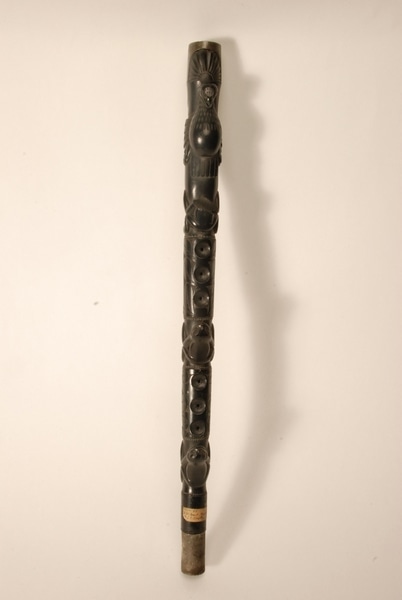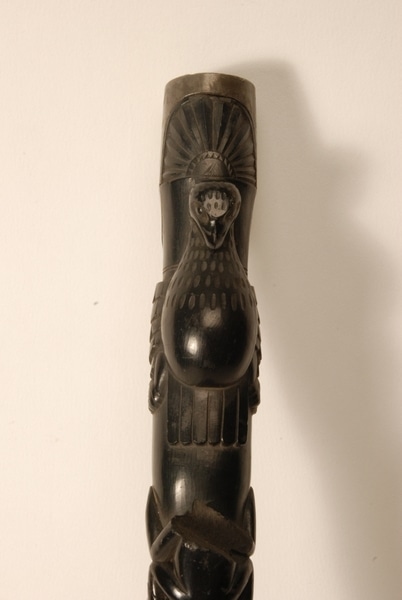Flute Item Number: E 1900.65 from the MAA: University of Cambridge




Description
The central section of a flute carved in argillite. At both ends are pieces of metal (lead or pewter) set into the argillite, one end is a tube-like section covering a slightly narrower end, the other is a shaped inlay. Along the length of the flute are three frogs (one has had its head broken off). In between the frogs are the stop holes, positioned in decorative bands of curleque and leaf motifs. At the metal inlay end is an eagle with a protruding belly, tail flat against the flute barrel, and wings and legs wrapped round the back and sides. The eagles' beak is slightly open and its head is raised from the surface, behind the head is grooved fan-like design.; Good
Context
This flute was possibly made in Skidegate, Queen Charlotte Islands by an Eagle chief George Gunya, who also owned the frog crest, and is known to have specialised in flutes with frogs sitting along the top surface. The identity of the carver is also given in Marius Barbeau' s Haida Carvers in Argillite (1957), page 8. This flute is almost identical to one in the British Columbian Provincial Museum, No.10780, which originally belonged to the artist Emily Carr and was given by her to William Newcombe (See Argillite, The Art of the Haida Leslie Drew and Douglas Wilson, 1980, Hancock House:Vancouver, page 185). In 1994 Dr George MacDonald, of the Canadian Museum of Civilisation, suggested that the flute was the work of Charles Edenshaw. The original European tribal names and, where possible, current tribal names have both been given in separate GLT fields.; Major production of flutes is thought to have been between 1840-1860, and they were made for sale to tourists. The flute is more accurately called a recorder since it has a mouth piece at one end, rather than on the side. The style of this flute conforms to those of the Second Period of argillite carving, 1830 -1865. This was the time when the Haida confidently depicted aspects of European culture created in a uniquely Haida medium and expressed with the characteristic detail of observation.
Item History
- Made in British Columbia, Canada
- Received from C.J.L. Allix during 1900
What
- Name
- Flute
- Identification Number
- E 1900.65
- Type of Item
- flute
- Material
- argillite stone
Who
- Culture
- Haida
- Received from
- C.J.L. Allix
Where
- Holding Institution
- MAA: University of Cambridge
- Made in
- British Columbia, Canada
When
- Acquisition Date
- during 1900
Other
- Keyword
- Music; Tourist Objects